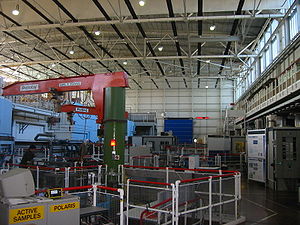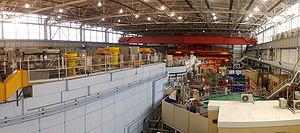
ISIS neutron source
Encyclopedia


Neutron
The neutron is a subatomic hadron particle which has the symbol or , no net electric charge and a mass slightly larger than that of a proton. With the exception of hydrogen, nuclei of atoms consist of protons and neutrons, which are therefore collectively referred to as nucleons. The number of...
and muon
Muon
The muon |mu]] used to represent it) is an elementary particle similar to the electron, with a unitary negative electric charge and a spin of ½. Together with the electron, the tau, and the three neutrinos, it is classified as a lepton...
source. It is situated at the Rutherford Appleton Laboratory
Rutherford Appleton Laboratory
The Rutherford Appleton Laboratory is one of the national scientific research laboratories in the UK operated by the Science and Technology Facilities Council . It is located on the Harwell Science and Innovation Campus at Chilton near Didcot in Oxfordshire, United Kingdom...
on the Harwell Science and Innovation Campus
Harwell Science and Innovation Campus
The Harwell Science and Innovation Campus is a science and technology campus near the villages of Harwell and Chilton, Oxfordshire, England. The site is about south of Oxford...
in Oxfordshire
Oxfordshire
Oxfordshire is a county in the South East region of England, bordering on Warwickshire and Northamptonshire , Buckinghamshire , Berkshire , Wiltshire and Gloucestershire ....
, United Kingdom and is part of the Science and Technology Facilities Council
Science and Technology Facilities Council
The Science and Technology Facilities Council is a UK government body that carries out civil research in science and engineering, and funds UK research in areas including particle physics, nuclear physics, space science and astronomy .-History:It was formed in April 2007 as a merger of the Particle...
. It uses the techniques muon spectroscopy
Muon spin spectroscopy
Muon spin spectroscopy is an experimental technique based on the implantation of spin-polarized muons in matter and on the detection of the influence of the atomic, molecular or crystalline surroundings on their spin motion...
and neutron scattering
Neutron scattering
Neutron scattering,the scattering of free neutrons by matter,is a physical processand an experimental technique using this processfor the investigation of materials.Neutron scattering as a physical process is of primordial importance...
to probe the structure and dynamics of condensed matter
Condensed Matter
Condensed matter may refer to several things*Condensed matter physics, the study of the physical properties of condensed phases of matter*European Physical Journal B: Condensed Matter and Complex Systems, a scientific journal published by EDP sciences...
on a microscopic scale ranging from the subatomic to the macromolecular.
Hundreds of experiments are performed annually at ISIS by visiting researchers from around the world, in diverse science areas including physics
Physics
Physics is a natural science that involves the study of matter and its motion through spacetime, along with related concepts such as energy and force. More broadly, it is the general analysis of nature, conducted in order to understand how the universe behaves.Physics is one of the oldest academic...
, chemistry
Chemistry
Chemistry is the science of matter, especially its chemical reactions, but also its composition, structure and properties. Chemistry is concerned with atoms and their interactions with other atoms, and particularly with the properties of chemical bonds....
, materials engineering, earth sciences, biology
Biology
Biology is a natural science concerned with the study of life and living organisms, including their structure, function, growth, origin, evolution, distribution, and taxonomy. Biology is a vast subject containing many subdivisions, topics, and disciplines...
and archaeology
Archaeology
Archaeology, or archeology , is the study of human society, primarily through the recovery and analysis of the material culture and environmental data that they have left behind, which includes artifacts, architecture, biofacts and cultural landscapes...
.
Neutrons and muons
Neutrons are uncharged constituents of atomAtom
The atom is a basic unit of matter that consists of a dense central nucleus surrounded by a cloud of negatively charged electrons. The atomic nucleus contains a mix of positively charged protons and electrically neutral neutrons...
s and penetrate materials well, deflecting only from the nuclei
Atomic nucleus
The nucleus is the very dense region consisting of protons and neutrons at the center of an atom. It was discovered in 1911, as a result of Ernest Rutherford's interpretation of the famous 1909 Rutherford experiment performed by Hans Geiger and Ernest Marsden, under the direction of Rutherford. The...
of atoms. The statistical accumulation of deflected neutrons at different positions beyond the sample can be used to find the structure of a material, and the loss or gain of energy by neutrons can reveal the dynamic behaviour of parts of a sample, for example diffusive processes in solids. At ISIS the neutrons are created by accelerating 'bunches' of proton
Proton
The proton is a subatomic particle with the symbol or and a positive electric charge of 1 elementary charge. One or more protons are present in the nucleus of each atom, along with neutrons. The number of protons in each atom is its atomic number....
s in a synchrotron
Synchrotron
A synchrotron is a particular type of cyclic particle accelerator in which the magnetic field and the electric field are carefully synchronised with the travelling particle beam. The proton synchrotron was originally conceived by Sir Marcus Oliphant...
, then colliding these with a heavy tungsten
Tungsten
Tungsten , also known as wolfram , is a chemical element with the chemical symbol W and atomic number 74.A hard, rare metal under standard conditions when uncombined, tungsten is found naturally on Earth only in chemical compounds. It was identified as a new element in 1781, and first isolated as...
metal target, under a constant cooling load to dissipate the heat from the 160 kW proton beam. The impacts cause neutrons to spall
Spallation
In general, spallation is a process in which fragments of material are ejected from a body due to impact or stress. In the context of impact mechanics it describes ejection or vaporization of material from a target during impact by a projectile...
off the tungsten atoms, and the neutrons are channelled through guides, or beamline
Beamline
In particle physics, a beamline is the line in a linear accelerator along which a beam of particles travels. It may also refer to the line of travel within a bending section such as a storage ring or cyclotron, or an external beam extracted from a cyclic accelerator.In materials science, physics,...
s, to about 20 instruments, individually optimised for the study of different types of matter. The target station and most of the instruments are set in a large hall. Neutrons are a dangerous form of radiation, so the target and beamlines are heavily shielded with concrete.
ISIS produces muon
Muon
The muon |mu]] used to represent it) is an elementary particle similar to the electron, with a unitary negative electric charge and a spin of ½. Together with the electron, the tau, and the three neutrinos, it is classified as a lepton...
s by colliding a fraction of the proton beam with a graphite
Graphite
The mineral graphite is one of the allotropes of carbon. It was named by Abraham Gottlob Werner in 1789 from the Ancient Greek γράφω , "to draw/write", for its use in pencils, where it is commonly called lead . Unlike diamond , graphite is an electrical conductor, a semimetal...
target, producing pion
Pion
In particle physics, a pion is any of three subatomic particles: , , and . Pions are the lightest mesons and they play an important role in explaining the low-energy properties of the strong nuclear force....
s which decay rapidly into muons, delivered in a spin-polarised beam to sample stations.

Science at ISIS
ISIS is administered and operated by the Science and Technology Facilities CouncilScience and Technology Facilities Council
The Science and Technology Facilities Council is a UK government body that carries out civil research in science and engineering, and funds UK research in areas including particle physics, nuclear physics, space science and astronomy .-History:It was formed in April 2007 as a merger of the Particle...
(previously CCLRC). Experimental time is open to academic users from funding countries and is applied for through a twice-yearly 'call for proposals'. Research allocation, or 'beam-time', is allotted to applicants via a peer-review process. Users and their parent institutions do not pay for the running costs of the facility, which are as much as £11,000 per instrument per day. Their transport and living costs are also refunded whilst carrying out the experiment. Most users stay in Ridgeway House, a hotel near the site, or at Cosener's House
Cosener's House
The Cosener's House is on an island in the River Thames within the original grounds of Abingdon Abbey, located near the centre of the town of Abingdon, Oxfordshire, England. It is run as a conference centre with accommodation by the Science and Technology Facilities Council...
, an STFC-run conference centre in Abingdon
Abingdon, Oxfordshire
Abingdon or archaically Abingdon-on-Thames is a market town and civil parish in Oxfordshire, England. It is the seat of the Vale of White Horse district. Previously the county town of Berkshire, Abingdon is one of several places that claim to be Britain's oldest continuously occupied town, with...
. Over 600 experiments by 1600 users are completed every year.
A large number of support staff operate the facility, aid users, and carry out research, the control room is staffed 24 hours a day, every day of the year. Instrument scientists oversee the running of each instrument and liaise with users, and other divisions provide sample environment, data analysis and computing expertise, maintain the accelerator, and run education programmes. ISIS is also one of the few neutron facilities to have a significant detector group that researches and develops new techniques for collecting data.
Among the important and pioneering work carried out was the discovery of the structure of high-temperature superconductors and the solid phase of buckminster-fullerene.
Construction for a second target station started in 2003, and the first neutrons were delivered to the target on December 14, 2007. It will use low-energy neutrons to study soft condensed matter
Condensed Matter
Condensed matter may refer to several things*Condensed matter physics, the study of the physical properties of condensed phases of matter*European Physical Journal B: Condensed Matter and Complex Systems, a scientific journal published by EDP sciences...
, biological systems, advanced composites
Composite material
Composite materials, often shortened to composites or called composition materials, are engineered or naturally occurring materials made from two or more constituent materials with significantly different physical or chemical properties which remain separate and distinct at the macroscopic or...
and nanomaterials
Nanotechnology
Nanotechnology is the study of manipulating matter on an atomic and molecular scale. Generally, nanotechnology deals with developing materials, devices, or other structures possessing at least one dimension sized from 1 to 100 nanometres...
. To supply the extra protons for this, the accelerator is being upgraded.
History and background of ISIS
The source was approved in 1977 for the RAL site on the Harwell campus and recycled components from earlier UK science programmes including the accelerator hall which had previously been occupied by the NimrodNimrod (synchrotron)
Nimrod was a 7 GeV proton synchrotron operating in the Rutherford Appleton Laboratory in the United Kingdom between 1964 and 1978. It was used forstudies of nuclear and sub-nuclearphenomena...
accelerator. The first beam was produced in 1984, and the facility was formally opened by the then Prime Minister Margaret Thatcher
Margaret Thatcher
Margaret Hilda Thatcher, Baroness Thatcher, was Prime Minister of the United Kingdom from 1979 to 1990...
in October 1985.
The name ISIS is not an acronym: it refers to the Ancient Egyptian goddess
Isis
Isis or in original more likely Aset is a goddess in Ancient Egyptian religious beliefs, whose worship spread throughout the Greco-Roman world. She was worshipped as the ideal mother and wife as well as the matron of nature and magic...
and the local name for the River Thames
River Thames
The River Thames flows through southern England. It is the longest river entirely in England and the second longest in the United Kingdom. While it is best known because its lower reaches flow through central London, the river flows alongside several other towns and cities, including Oxford,...
. The name was selected for the official opening of the facility in 1985, prior to this it was known as the SNS, or Spallation Neutron Source. The name was considered appropriate as Isis was a goddess who could restore life to the dead, and ISIS made use of equipment previously constructed for the Nimrod
Nimrod (synchrotron)
Nimrod was a 7 GeV proton synchrotron operating in the Rutherford Appleton Laboratory in the United Kingdom between 1964 and 1978. It was used forstudies of nuclear and sub-nuclearphenomena...
and Nina accelerators.

